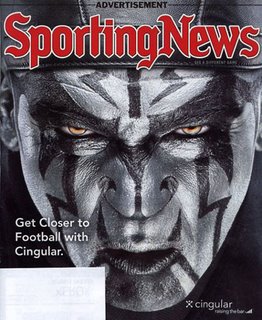
I glanced at my September 15 “The Sporting News” magazine and—between the other mail resting on top of it—could catch glimpses of a silver and black face. I could definitely see the distinctive red Gothic Sporting News logo. I thought they must be doing a cover story on football fans, possibly just the Raiders renowned fans. I scanned the only blurb on the cover and thought it read “Get Closer to Football with ...” something that started with a capital C. I thought it must be someone’s name.
A little later I returned to read the magazine and noticed the word I hadn’t made out was Cingular. Cingular?!? On the cover?!? Then I noticed the Cingular logo and slogan in the lower right-hand corner. To my horror, I turned the page and realized this was a wraparound cover. There was the repeat of the logo in the magazine’s regular style and the magazine’s “real” cover.
The Cingular ad was carried on both inside covers of the fake cover, with Head & Shoulders being run on the back of both the fake and real covers. Only when I went back to the fake cover one more time did I see in small black caps across the top: ADVERTISEMENT. But still...
The American Society of Magazine Editors, the professional organization of editors of consumer and business publications that’s part of Magazine Publishers Association, asks its members to abide by a code of ethics that calls for the strict separation of editorial and advertising, especially associated with covers and logos. ASME has published letters admonishing “Seventeen” for its April 2005 MTV issue and “The New Yorker” for suggesting Target’s logo into its cover. But ASME has no real leverage, and most publishers pocket the money, sometimes even without an apology, and go on.
This is just an extension of what TSN has been doing on its inside pages, with sponsored columns and features. In this same issue, there was the GMC Blog Like the Pros column and “The NFL’s 101 Best,” sponsored by Build Ford Tough Bold Moves with the Ford logo next to the title. Did Ford help the editors, who we count on to be experts, decide who was part of that 101 best? Did they try to get more Detroit players named? Probably not, but the question is raised.
TSN struggles for ad dollars with SI and ESPN magazines and is now up for sale by Paul Allen, the Microsoft founder, who bought it several years ago from Times Mirror Co. Maybe offering prime space and lending its brand to companies seem the only way to compete. But, really, at what cost to the magazine’s credibility and integrity?
I suppose an ad cover like this should be no surprise in the sports world, where almost every square inch of real estate associated with our games is up for sale, including sidelines, walls behind home plate and elsewhere, all over stadiums, on some uniforms, even—almost—on the bases for MLB games. And is it any different than radio and TV spots that are sponsored by one product or another? For me, it feels different and so much worse. TSN was started in 1886 and bills itself as “the first newsweekly in sports,” so the connection, even the implied endorsement, between the venerable TSN brand and Cingular seems to me to threaten the magazine’s status as sports bible of facts and analysis. It now seems willing to bebillboard space, selling its pages and readers--if not its soul.
 This headline made me think of how difficult it is to teach objective sports journalism. We've always had sports homers (and I'm not picking on the St. Louis Post-Dispatch; plenty of other outlets get into the "we" and "us" mentality), but it seems to really have grown in recent years. Part of it is the growth in the number of sports media outlets. With so many channels and web sites available, there seems to be a niche for every opinion. Media outlets need audience, and playing it straight doesn't necessarily drive ratings (just ask radio sports-talk stations). I also think there are more students getting into sports journalism as fans instead of journalists. They want to ride on the bandwagon without doing all the hard, behind-the-scenes work.
This headline made me think of how difficult it is to teach objective sports journalism. We've always had sports homers (and I'm not picking on the St. Louis Post-Dispatch; plenty of other outlets get into the "we" and "us" mentality), but it seems to really have grown in recent years. Part of it is the growth in the number of sports media outlets. With so many channels and web sites available, there seems to be a niche for every opinion. Media outlets need audience, and playing it straight doesn't necessarily drive ratings (just ask radio sports-talk stations). I also think there are more students getting into sports journalism as fans instead of journalists. They want to ride on the bandwagon without doing all the hard, behind-the-scenes work.

